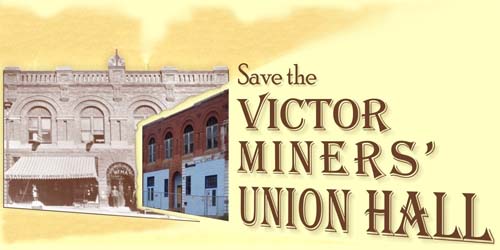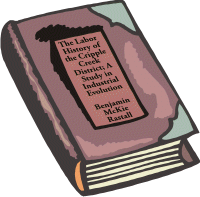 |
Victor
|
The Labor History of the Cripple Creek District;
A Study in Industrial Evolution
by Benjamin McKie Rastall

pages 139-141
CHAPTER VI
DISCUSSIONS AND CONCLUSIONS
The Western Federation Of Miners—Its Side Of The Case
The Western Federation of Miners was organized in a convention held at Butte, Montana, May 15th, 1893. Forty delegates, representing fifteen unions from the states of Colorado, Utah, Montana, Idaho, and South Dakota, assembled, drafted a constitution, and began an active campaign for general organization.1 The first Cripple Creek strike came six months later, while the movement was in its infancy, and the Federation hardly more than a name. The Altman union secured a charter in the general organization, and this was utilized by the striking miners to secure uniformity and authority in their actions, but the Western Federation of Miners as a body had no connection with the strike.2
The Federation has grown steadily since its organization. By 1903 its unions numbered 200, and its jurisdiction extended over the Rocky Mountains and far western states, and British Columbia. Five hospitals are owned by it, and several cooperative stores at various mining centers. Some of the local unions provide sick benefit, and maintain wards in the local hospitals, and many of them have halls with libraries, reading rooms, and rooms for social entertainment.3
During the first years of its existence the Federation changed officers every year, but from 1896 to 1906 the office of president has been held by but two men, Edward Boyce and Charles H. Moyer.4 William D. Haywood, elected secretary-treasurer in 1901 has held the position ever since.5 At the end of his sixth year in office Mr. Boyce positively refused re-election, and closed his career in a stirring speech that became a classic to his followers. Its dominant note was an appeal to class consciousness, and its climax a demand for socialistic action.6 When the convention closed it had voted confidence in the words of its president, and declared itself with the Socialist Party of America.7 President Moyer and Secretary-Treasurer Haywood, radically socialistic in their own views, lost no opportunity to direct the activity of the organization more and more into socialistic channels.8 The rank and file of the membership hung back, and did not accept socialistic ideas nearly so generally as has been supposed. At their annual conventions the delegates repeatedly refused to pass extreme resolutions asked for by the leaders.9 But the Federation has been strongly under the influence of its officers these last years.10 It is its misfortune that these men have been extremists. Its catastrophies have been mistakes of leadership.
The Federation man in speaking of the Cripple Creek difficulties prefers to merge them with the general strike difficulties of the time.11 The struggle over the eight-hour question, and the wrongs done by capital therein loom large to him, and Cripple Creek is merely a phase of the general situation. The Colorado City difficulty is the immediate irritant. Here the union just formed is all but broken up by the summary discharge of its members from the employ of the Colorado Reduction and Refining Company. A strike is the remedy, a verbal agreement being reached at last, the union acting under pressure, and coming two-thirds of the way. But the company does not fulfill its agreement satisfactorily—work is offered the men in such a way that they will not accept it—the management will not consider the wage scale. The other mills, which have made entirely satisfactory adjustments, become dissatisfied, and threaten to lower wages again unless the Colorado mill is forced into line. So a second strike is called. But the hostile attitude of the management has been so effective that the strike is unsuccessful. There is danger that all that has been gained will be lost if the mill cannot be controlled. Its ore can be shut off. The Cripple Creek miners are of the same organization and should support their brothers. There is added irritation in that some of the Cripple Creek mines refuse to employ union men at all. The capitalistic class in Colorado is pushing labor to the last ditch, and throttling its every move for Betterment. The time for a decisive blow against such tyranny is at hand. So the miners are called out.12
1Information furnished by the unions. See also Special Report Commissioner of Labor. U. S. Chap. I.
Also Langdon, Mrs. Emma F. The Cripple Creek Strike, Introduction.
2See p. 20.
3Information furnished by the unions. See also Special Report Commissioner of Labor, U. S., Chap. I.
The federation does not report its membership. The report of the Colorado Bureau of Labor Statistics for 1901-2 estimated the membership at 48,000.
4Official Reports Western Federation.
5Ibid.
6Ibid.
Copy officially published by federation. Also In Official Proceedings for 1902.
7Ibid.
8Ibid.
9See page 10, 2nd par., also f. n. 1.
10See pages 25, f. n. 1, 36 and 37, Including f. n., and page 13.
11A digest is here given of the statements of the case by various union officers.
12Official Reports Western Federation.
NEXT: History of the organization — The card system — Sympathetic view of its position